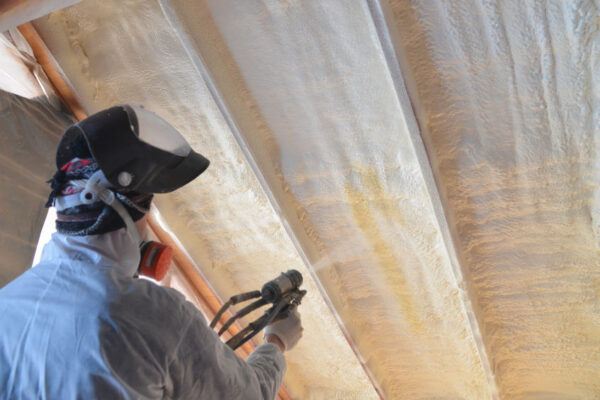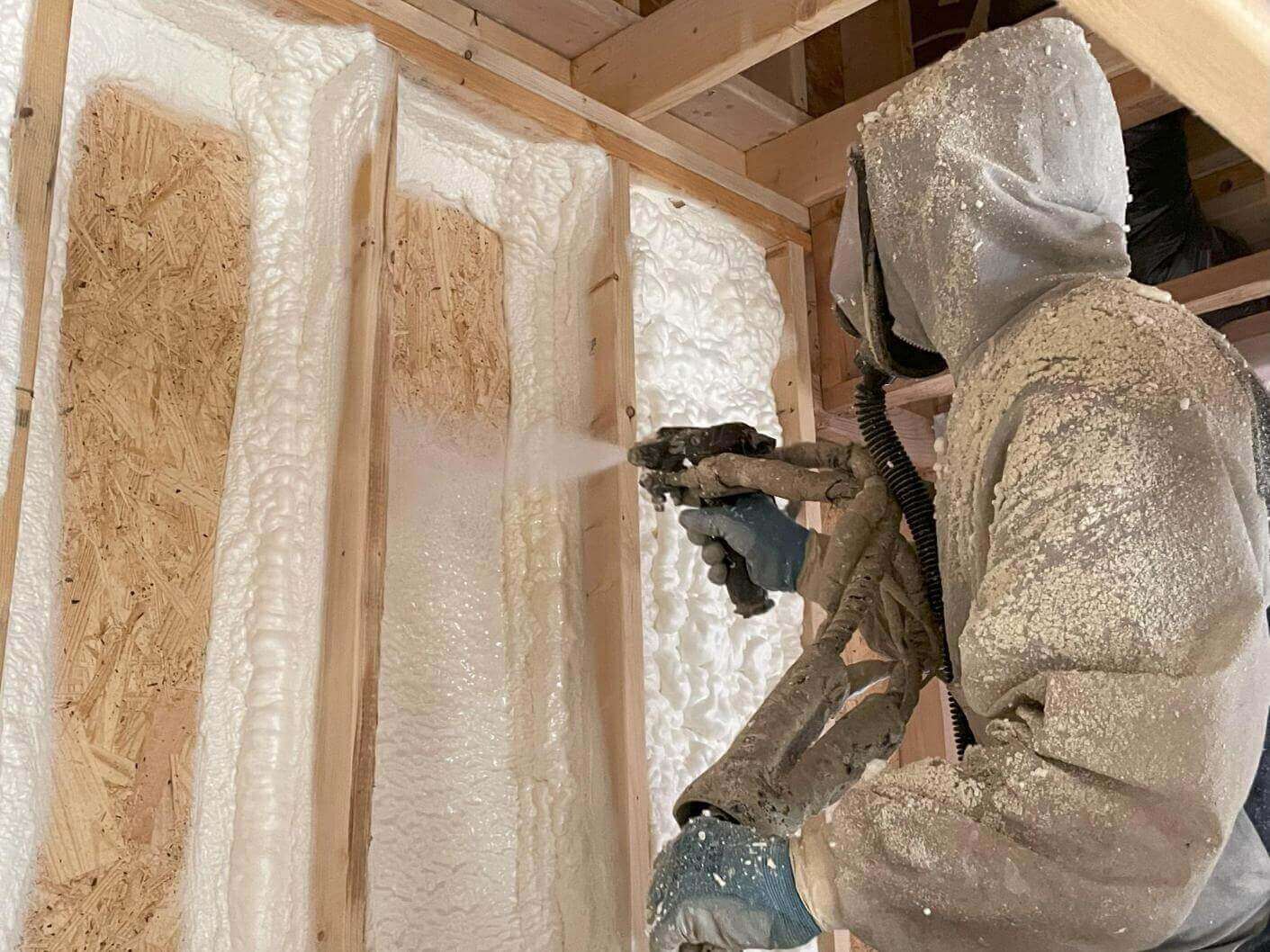Spray Foam: The Ultimate Remedy for Air Sealing and Insulation
Spray foam insulation has arised as a leading option for efficient air securing and thermal insulation, supplying a distinct combination of residential or commercial properties that set it besides conventional techniques. Its capacity to increase and load spaces makes it specifically effective in avoiding air leak, which can substantially influence power performance. Understanding the full scope of its benefits, setup processes, and comparisons with other insulation types is vital for making educated choices. As we discover these facets, the implications for both brand-new buildings and retrofits come to be increasingly significant. What factors should influence your selection?
What Is Spray Foam?
Spray foam is a versatile insulation material that integrates the concepts of air sealing and thermal resistance to boost energy performance in buildings. Made up largely of polyurethane or various other similar compounds, spray foam is used as a fluid that expands upon contact with surfaces, creating a strong, constant layer of insulation. This distinct building allows it to load gaps, splits, and gaps that typical insulation materials may overlook, supplying an exceptional air seal.
There are two primary kinds of spray foam: open-cell and closed-cell. Open-cell spray foam is lighter and extra adaptable, supplying superb noise absorption and a lower R-value per inch - Spray Foam. In comparison, closed-cell spray foam is denser, providing a higher R-value, moisture resistance, and included architectural integrity to constructing parts
The application process normally entails specific equipment, ensuring a seamless application that sticks to numerous substrates, consisting of steel, wood, and concrete. This flexibility makes spray foam ideal for both brand-new constructions and retrofitting existing structures. Its capacity to develop an impermeable barrier considerably adds to minimizing power intake and improving interior air quality, therefore making it a preferred option amongst builders and property owners alike.
Advantages of Spray Foam Insulation
One of one of the most considerable advantages of spray foam insulation is its outstanding capacity to develop a continual air obstacle, which efficiently lessens energy loss. Unlike conventional insulation materials, spray foam broadens to fill up splits and voids, making sure that air leak is substantially minimized. This particular not only improves energy effectiveness but also results in reduce utility costs with time.
Additionally, spray foam insulation offers superior thermal resistance, contributing to an extra stable indoor atmosphere. Its high R-value per inch permits efficient insulation in constrained areas, making it optimal for attics, wall surfaces, and crawl rooms. In addition, the moisture-resistant homes of spray foam aid avoid mold and mold growth, promoting much healthier living problems.
Another essential advantage of spray foam insulation is its sound-dampening qualities (Spray Foam). It properly lowers noise transmission in between rooms, developing a quieter and a lot more comfy home environment. The durability of spray foam also stands apart, as it does not droop or work out with time, maintaining its efficiency throughout its life expectancy
Exactly How Spray Foam Works
Recognizing exactly how spray foam insulation works is important for appreciating its efficiency in air sealing and thermal resistance. Spray foam insulation is composed of two main parts: isocyanate and polyol resin. When these elements are blended, they undergo a chemical reaction that triggers the product to broaden rapidly, developing a dense foam that loads cracks, voids, and dental caries.
As the foam broadens, it follows surface areas, forming an impermeable seal that considerably reduces air seepage. This characteristic makes spray foam insulation highly reliable at stopping drafts and moisture penetration, which can cause power loss and damages with time. In addition, the closed-cell variation of spray foam uses exceptional thermal resistance due to its inflexible structure, properly lessening warm transfer.
The one-of-a-kind homes of spray foam allow it to comply with uneven surface areas, ensuring detailed insurance coverage and a seamless obstacle. As an outcome, spray foam insulation not just enhances power performance but likewise adds to enhanced indoor air high quality by minimizing the buildup of allergens and toxins. Eventually, comprehending the auto mechanics behind spray foam emphasizes its duty as a remarkable option for insulation and air sealing in both property and commercial applications.
Setup Refine Summary

Prior to installment, the space must be properly cleaned and prepped, guaranteeing that surface areas are without particles, wetness, and dirt. This step is vital because contaminants can jeopardize bond and general efficiency. When the area is prepared, the application involves blending the 2 components of the spray foam, which expands upon call and fills spaces successfully.
Educated experts must perform the installment, utilizing specific equipment to ensure consistent coverage and optimal thickness. Safety and security precautions, consisting of wearing safety equipment and making certain proper ventilation, are important during this procedure. After application, the foam normally cures promptly, creating a strong obstacle that improves power effectiveness.
Comparing Spray Foam to Standard Insulation
When evaluating insulation options, spray foam insulation stands out in contrast to traditional products such as fiberglass and cellulose. Unlike fiberglass and cellulose, which can allow air seepage, spray foam broadens upon application, filling gaps and holes to develop a closed seal.
Furthermore, spray foam gives a greater R-value per inch than conventional insulation kinds, using even more effective thermal resistance in a thinner profile. This characteristic is especially advantageous precede with minimal dental caries depth. Spray foam is resistant to dampness and mold and mildew development, which can be a considerable concern with cellulose and fiberglass, particularly in humid environments.
However, spray foam insulation usually lugs a higher in advance cost than its standard equivalents. Homeowners must weigh this preliminary financial investment versus long-term power savings and you can find out more efficiency benefits. Eventually, while both insulation kinds offer their function, spray foam becomes an advanced remedy for modern-day insulation requirements, especially in regards to air securing and thermal efficiency.

Verdict
In recap, spray foam insulation stands for an extremely reliable service for achieving optimum air securing and thermal resistance. Its special residential or commercial properties, including dampness resistance and noise dampening, make it ideal for various applications in both brand-new buildings and retrofitting jobs (Spray Foam). Although the first prices may be higher compared to typical insulation materials, the lasting benefits, such as significant energy financial go to the website savings and boosted interior air quality, validate the investment and underscore its worth in modern structure methods.
Spray foam insulation has actually emerged as a leading service for reliable air securing and thermal insulation, using an unique combination of homes that set it apart from traditional methods.Spray foam is a flexible insulation product that incorporates the concepts of air securing and thermal resistance to improve energy performance in structures.When assessing insulation choices, spray foam insulation stands out in contrast to traditional materials such as fiberglass and cellulose. Eventually, while both insulation types offer their function, spray foam arises as an extra advanced option for modern insulation requirements, particularly in terms of air sealing and thermal performance.
In summary, spray foam insulation represents a highly effective solution for achieving optimal air sealing and thermal resistance.